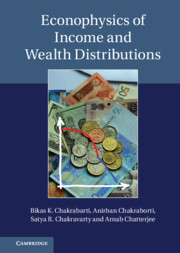Book contents
- Frontmatter
- Contents
- Preface
- 1 Introduction
- 2 Income and wealth distribution data for different countries
- 3 Major socioeconomic modelling
- 4 Market exchanges and scattering process
- 5 Analytic structure of the kinetic exchange market models
- 6 Microeconomic foundation of the kinetic exchange models
- 7 Dynamics: generation of income, inequality and development
- 8 Outlook
- References
- Index
5 - Analytic structure of the kinetic exchange market models
Published online by Cambridge University Press: 05 May 2013
- Frontmatter
- Contents
- Preface
- 1 Introduction
- 2 Income and wealth distribution data for different countries
- 3 Major socioeconomic modelling
- 4 Market exchanges and scattering process
- 5 Analytic structure of the kinetic exchange market models
- 6 Microeconomic foundation of the kinetic exchange models
- 7 Dynamics: generation of income, inequality and development
- 8 Outlook
- References
- Index
Summary
The kinetic exchange models of markets provide a simplified – perhaps oversimplified – picture of the exchange mechanism that takes place in a real market. However, the simple, “toy model” paradigm also offers interesting grounds for possible analytic formulation, compared with real markets where the dynamics involve plenty of parameters and involve complex evolution that render them intractable and incomprehensible.
In this chapter we will discuss in detail some of the simple and intuitive frameworks developed to understand the qualitative, and sometimes even the quantitative, aspects of simple kinetic exchange models discussed in the previous chapters. Most of our discussions will include the CC (Chakraborti and Chakrabarti 2000) and the CCM (Chatterjee et al. 2004) models, and some of their important variants, which are easy to handle analytically, or in cases where their solutions can be argued intuitively.
Analytic results for the CC model
The earliest attempt to understand the CC model analytically (Das and Yarla–gadda 2003) assumes that, independent of the initial conditions, the system evolves to an equilibrium distribution after a suficiently long time. Thus, in the steady state, the joint probability that, before interaction, money of i lies between x and x + dx and that of j lies between z and z + dz is f(x)dxf(z)dz.Since each interaction conserves total money, let L = x + z.
- Type
- Chapter
- Information
- Econophysics of Income and Wealth Distributions , pp. 114 - 149Publisher: Cambridge University PressPrint publication year: 2013



